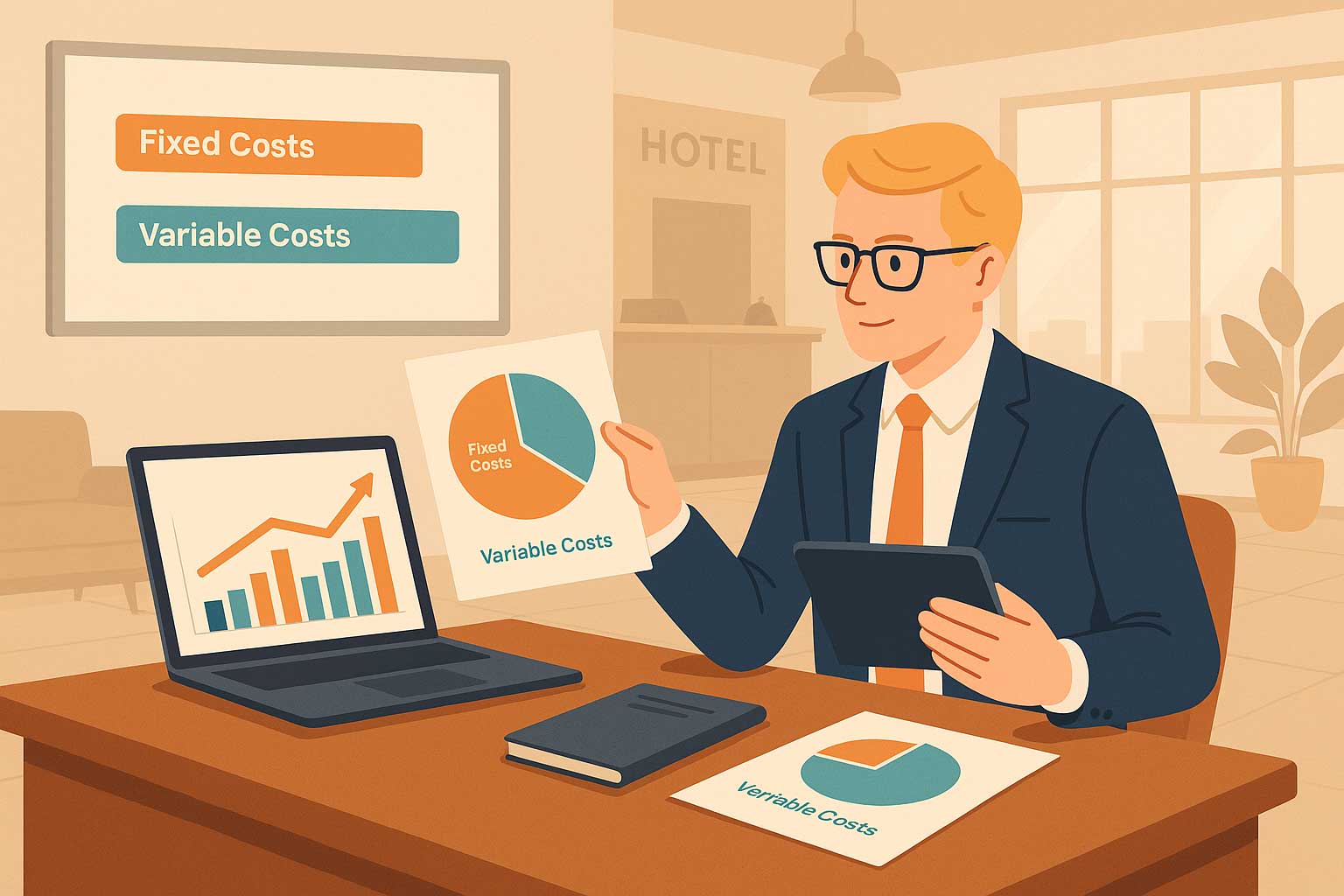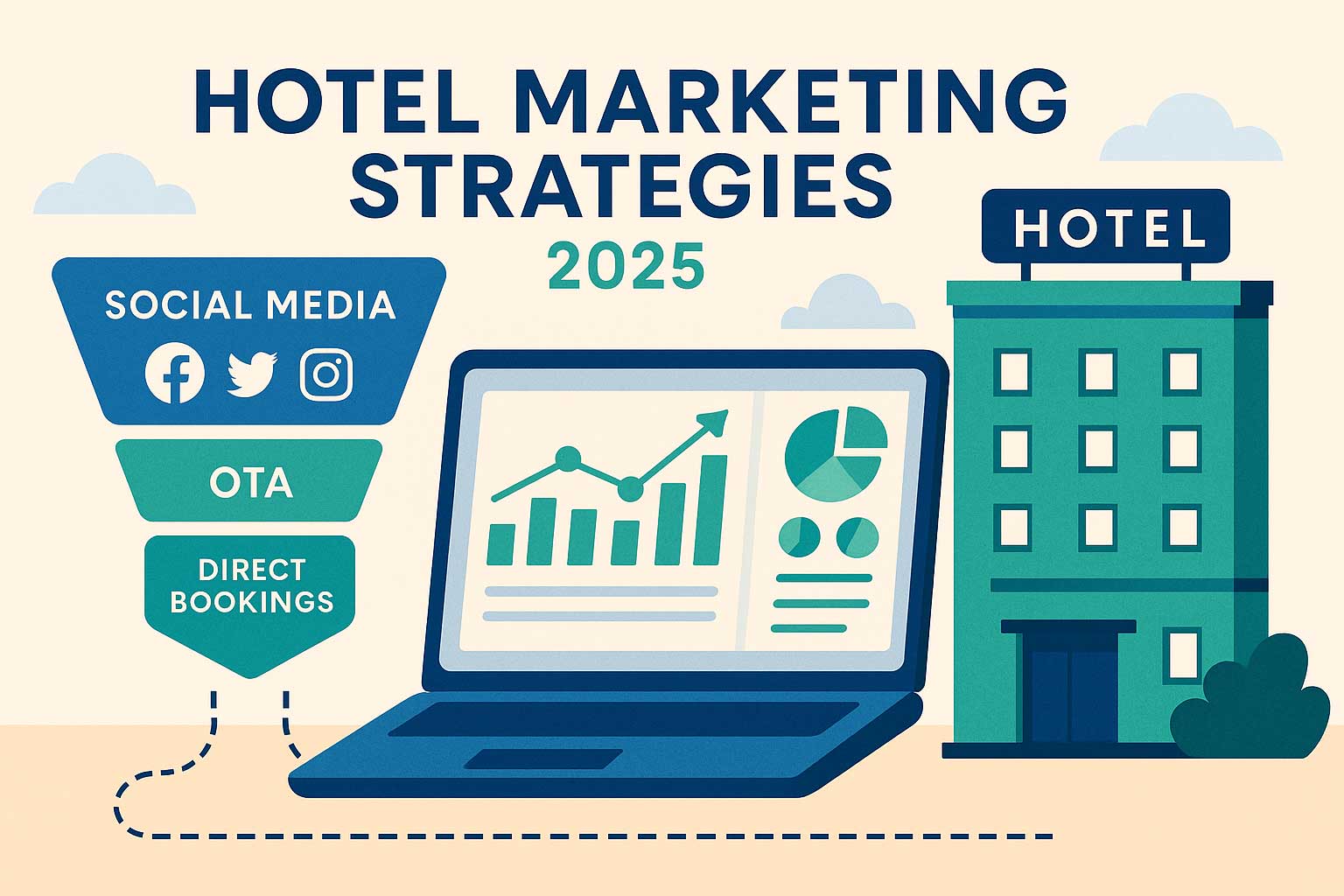Hotel Fixed and Variable Costs: Complete Management Guide
Aug 31, 2025
 Mika Takahashi
Mika TakahashiPopular Categories
Hotel Technology & InnovationHotel Operations OptimizationDigital MarketingIndustry TrendsRevenue ManagementHospitality Industry
Popular Categories
Trending Post

Hotel Walk Letter Template: Professional Guest Communication

Online Travel Agents: What They Are and How They Work

Hotel Security Systems: Modern Protection Solutions

Hotel Advertising: Complete Guide to Boost Bookings and Revenue

25 Hotel Marketing Strategy Ideas for 2025: Complete Guide

AI Reservation Agent: Revolutionizing Hotel Booking and Guest Experience

PMS Communication: Streamlining Property Management Through Effective Guest Messaging
Table of contents
In the world of hospitality, truly understanding your hotel’s cost structure can be the difference between turning a profit or facing losses. Labor costs alone often make up 35-50% of total operating expenses in many hotels, so managing these costs smartly is more important than ever if you want to stay competitive while keeping your margins healthy.
Hotel fixed and variable costs are the backbone of any successful hotel business model. Whether you’re running a cozy boutique inn or managing a large hotel chain, getting a handle on these cost categories helps you make smarter decisions about pricing, staffing, and how to improve operational efficiency.
This guide covers everything hotel managers need to know about managing costs effectively in 2025. You’ll find practical tips for optimizing both fixed and variable expenses, key performance indicators to track how well you’re doing, and technology tools that can help boost your revenue while cutting down waste.
Understanding Hotel Fixed and Variable Costs
When it comes to hotel operating costs, they generally fall into two main buckets that every management team should be familiar with. Fixed costs are those expenses that stay the same no matter how many guests you have. Whether your hotel is 20% full or packed at 95% occupancy during the same time frame, these costs don’t budge.
Variable costs, on the other hand, rise and fall depending on how many guests are staying with you. More guests mean higher variable expenses, and when occupancy dips, these costs go down too. This gives hotels some flexibility to adjust during slower periods.

Understanding the difference between fixed and variable costs is crucial because it directly impacts your hotel’s profitability and how you price your rooms. Knowing this relationship helps hotel managers figure out break-even points, fine-tune revenue management, and make smart choices about running the hotel more efficiently.
Here’s a simple formula every hotel manager should keep in mind: Total Hotel Costs = Fixed Costs + Variable Costs
This basic equation is at the heart of every pricing decision and financial goal your hotel sets. Hotels with a higher portion of fixed costs take on more risk when the economy slows down but often provide steadier guest services. Meanwhile, hotels with more variable costs can adapt faster to market changes but might find it harder to maintain service quality when cutting costs.
Examples of Hotel Fixed Costs
Fixed costs are the steady expenses that keep your hotel running regardless of how busy you are. Rent or mortgage payments are a prime example — you pay the same amount whether you rent out zero rooms or are fully booked.
Salaries for your core management team and full-time employees with fixed contracts also fall into this category. Your front desk managers, accountants, and other essential staff get paid the same regardless of occupancy, ensuring your hotel runs smoothly but adding fixed costs during slow periods.
Then there are property insurance premiums, business licenses, and regulatory fees. These usually come due annually or periodically, no matter how many guests you have. While these costs might increase a bit each year, they’re necessary for protecting your property and keeping your business compliant.
Property taxes and municipal charges are another big fixed expense. These are based on property value, not how well your hotel is doing, so they’re predictable but inflexible. You’ll want to plan carefully for these costs.
Depreciation on your furniture, fixtures, and equipment also counts as a fixed cost. This reflects the wear and tear on your assets over time, regardless of how many guests stay at your hotel.
Finally, some utilities have a fixed base charge. For example, your telephone and internet service plans come with minimum fees regardless of how much you use them, forming the fixed part of these otherwise variable expenses.
Examples of Hotel Variable Costs
Variable costs move up and down with guest activity, giving you chances to manage expenses dynamically. Housekeeping supplies like linens, toiletries, and cleaning products increase as more rooms are occupied. Keeping a tight inventory control here can make a big difference in your cost per occupied room.
Food and beverage expenses also fluctuate with guest demand, whether in your restaurant or through room service. Smart menu planning, portion control, and good supplier deals can help keep these costs in check.
Hourly wages for part-time housekeeping, maintenance, and guest services staff make up variable labor costs. Cross-training staff so they can fill multiple roles helps you adjust staffing based on expected occupancy without sacrificing service quality.
Utility bills for electricity, water, and gas vary with actual usage, which typically rises with occupancy. Energy costs can spike, especially if your property lacks automation. Upgrading to LED lighting and installing occupancy sensors can significantly lower these variable expenses.
Guest amenities like welcome gifts and in-room refreshments are variable costs that can enhance guest satisfaction. Choosing these amenities wisely allows you to balance cost control with providing a great guest experience, which in turn can boost repeat business.
Commissions paid to online travel agencies and booking platforms are purely variable, tied directly to reservations. These fees can eat up 10-25% of your room revenue. Encouraging direct bookings can help reduce these extra costs.
Semi-Variable Costs in Hotels
Some expenses have both fixed and variable parts, which means managing them takes a bit more nuance. For example, telecom bills usually include a fixed base fee plus charges that depend on usage by guests and staff.
Maintenance contracts often have a base fee for routine service plus extra charges for emergency repairs or wear and tear. Labor costs can also be a mix — salaried staff are fixed, but overtime and seasonal hires add variability. Good scheduling and cross-training help keep these costs balanced.
Key Performance Indicators for Cost Management
To know how well you’re managing costs, you need clear metrics that shed light on operational efficiency. One important measure is Cost Per Occupied Room (CPOR), which divides total room department costs by the number of occupied rooms. This helps you keep tabs on variable cost control.
The formula is straightforward: CPOR = Total Room Department Costs ÷ Total Occupied Rooms. Tracking this monthly can alert you to creeping costs and help spot opportunities to tighten spending.
Cost Per Available Room (CostPAR) looks at total costs divided by all available room nights, giving insight into your overall cost efficiency regardless of occupancy. It’s a great way to see how well fixed costs are covered and how efficient operations are during different demand levels.
Labor Per Available Room (LPAR) zeros in on labor costs per available room night. Since labor is often the biggest expense, keeping an eye on LPAR helps you optimize staffing without sacrificing guest service.
Variable Cost Percentage shows what portion of your total revenue goes to variable costs. Ideally, you want to keep this below 35% to maximize profitability.
Fixed Cost Coverage Ratio helps you understand what occupancy level you need to cover your fixed costs. This guides your pricing and break-even analysis for different scenarios.
Strategic Cost Management Approaches
Using flexible staffing models lets you turn fixed labor costs into variable ones during slower times while still maintaining service quality. This means cross-training your staff and partnering with temp agencies to cover busy periods without overstaffing.
Negotiating supplier contracts with volume discounts helps optimize variable costs while ensuring you have enough supplies during peak times. Long-term agreements can provide cost stability with operational flexibility.
Revenue management systems play a key role by ensuring your pricing covers both fixed and variable costs while maximizing profit. These tools analyze past data, market trends, and your cost structure to adjust room rates dynamically.
Creating departmental budgets that separate fixed and variable expenses improves transparency and accountability. This way, department heads can focus on controlling variable costs while understanding their fixed cost responsibilities.
Setting cost control protocols for different occupancy levels helps keep your hotel profitable no matter the demand. For example, you might have specific strategies for occupancy below 50%, between 50-80%, and above 80%.
Technology Solutions for Cost Optimization
Property Management Systems (PMS) that track cost per occupied room in real time give you immediate insight into how costs are performing. Modern PMS often integrate with accounting software to provide detailed cost analysis and forecasting.
Energy management systems automate control of variable utility costs through smart thermostats, lighting controls, and occupancy sensors. These investments usually pay off within 18-24 months and improve guest comfort at the same time.
Inventory management software helps optimize housekeeping supply orders by tracking usage patterns and predicting needs based on bookings. This reduces waste and ensures guests always have what they expect.
Labor scheduling platforms align staffing with predicted occupancy, turning fixed labor costs into variable ones while keeping service standards high. They factor in guest needs, staff availability, and cost efficiency all at once.
Automated procurement systems adjust orders based on booking forecasts, cutting waste and improving supplier relationships. Integrated with PMS data, they help you predict demand and control costs accurately.
Seasonal Cost Management Strategies
Peak seasons like June-August and the December holidays require you to adjust your variable cost budgets to handle higher demand while staying profitable. Expect to spend more on housekeeping supplies, energy, and hourly wages during these times.
Low occupancy periods such as January-February and post-holiday slumps call for careful planning to cover fixed costs while finding temporary ways to cut expenses without hurting future operations.
Shoulder seasons (March-May, September-November) are perfect for cost-saving measures and maintenance work. Timing major expenses and staff training during these slower months helps optimize your yearly budget.
Seasonal staffing plans balance cost control with guest service by using part-time and seasonal workers during busy periods. Cross-training ensures your core team can cover multiple roles when business slows down.

Industry Benchmarks and Best Practices
Industry standards suggest most hotels have about 60-65% fixed costs and 35-40% variable costs. If your property falls far outside these ranges, it’s worth reviewing your operational efficiency and cost management strategies.
Variable costs should ideally stay under 35% of total revenue for the best profitability. Hotels exceeding this threshold might be facing inefficiencies or pricing issues that don’t fully cover operating costs.
Benchmarking your Cost Per Occupied Room monthly against similar hotels gives you valuable competitive insights and highlights areas for improvement. Regional and segment-specific data is the most relevant for meaningful comparisons.
Tracking monthly changes in variable costs helps you spot trends and seasonal patterns to inform future planning. Keeping detailed records supports better annual budgeting and operational efficiency.
Holding weekly cost review meetings during peak seasons keeps expenses under control when they can change quickly. These meetings should involve department heads responsible for major cost areas and focus on immediate optimization opportunities.
Good cost management balances efficiency with guest satisfaction. Cutting costs at the expense of service often leads to lower occupancy and revenue down the line.
Many hotels run waste reduction programs that save money and support sustainability goals. These efforts include staff training, guest education, and tweaking operations.
Conclusion
Getting a handle on hotel fixed and variable costs is key to long-term profitability in today’s competitive hospitality market. Knowing the difference between these costs influences everything from pricing and staffing to guest services.
Successful cost management blends strategic planning with operational flexibility, helping hotels maintain quality while improving financial results. Technology, performance monitoring, and seasonal planning all play a role in building effective cost control.
By applying the strategies and tracking the metrics in this guide, hotel managers can boost operational efficiency, cut waste, and increase revenue — all while keeping guests happy and loyal. The secret is understanding your hotel’s unique cost structure and tailoring your approach to both fixed and variable expenses.
Remember, cost optimization is an ongoing journey. Market conditions, guest expectations, and operational needs are always evolving, so your cost management strategies should be flexible enough to keep pace and support both short-term profits and long-term growth.
